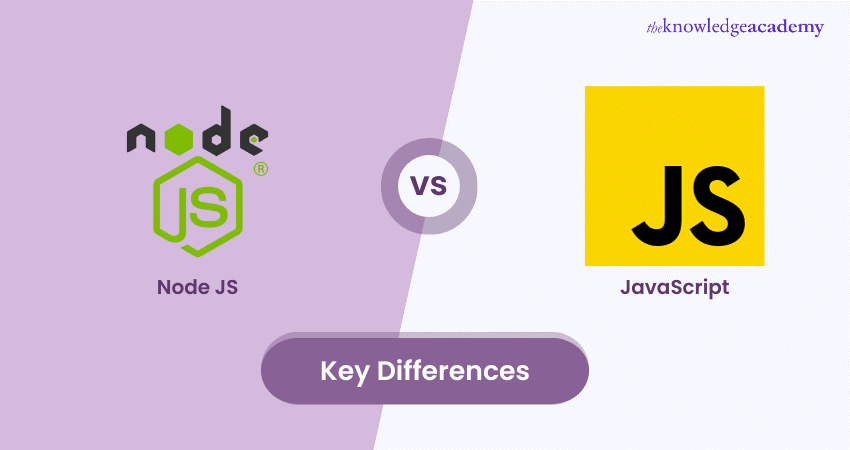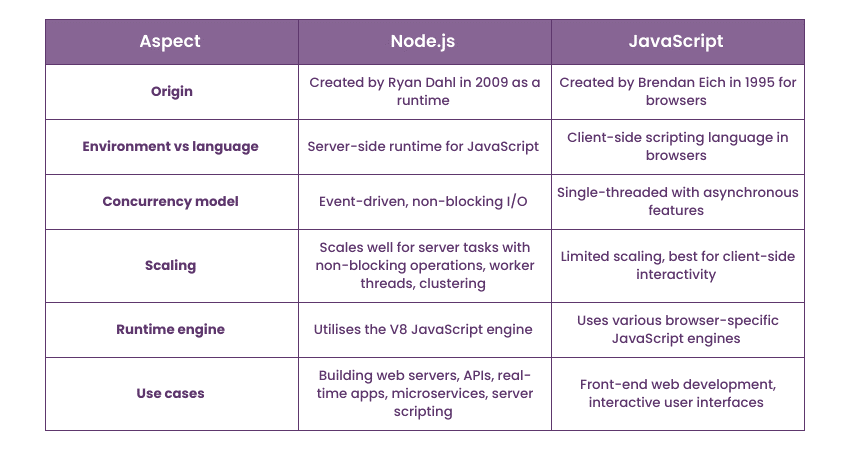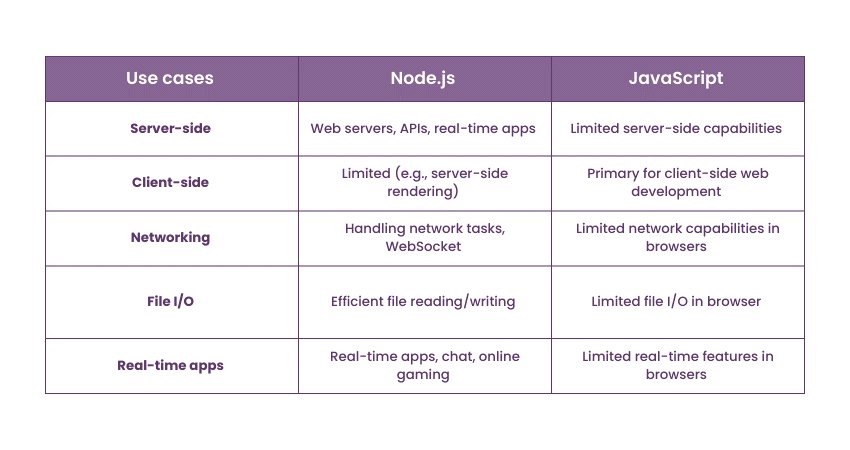We may not have the course you’re looking for. If you enquire or give us a call on +352 8002-6867 and speak to our training experts, we may still be able to help with your training requirements.
Training Outcomes Within Your Budget!
We ensure quality, budget-alignment, and timely delivery by our expert instructors.

Are you wondering which technology to use for your backend development? If so, you might have come across Node.js and Java, two of the most popular and widely used programming languages in web development. But when it comes to Node.js vs JAVA Script, how do they differ, and which one is better for your project?
Explore the distinctions between Node.js and JavaScript. Learn about their origins, use cases, and how they contribute to building dynamic web applications. By the end of this blog, you will have a clear idea of Node.js vs JavaScript.
Table of content
1) What is Node.js?
2) What is JavaScript?
3) Comparison of Node.js vs JavaScript
a) Origins
b) Environment vs language
c) Concurrency model
d) Scaling
e) Runtime engine
f) Use cases
4) Conclusion
What is Node.js?
Node.js is a platform that enables JavaScript to run on the server side. Node.js is popular for creating web applications, APIs, and microservices. Node.js is based on Google's V8 engine, which is a fast and efficient JavaScript engine written in C++. Node.js comes with many modules that can be imported from Node Package Manager, a package manager for Node.js. Node.js uses an event-driven and non-blocking Input/Output (I/O) model, meaning it can handle multiple requests. Node.js also uses a single-threaded event loop, reducing memory usage and avoiding context switching. Node.js is fast, scalable, secure, and flexible.
What is JavaScript?
JavaScript is a programming language that can run on web browsers and other environment. By manipulating the HTML and CSS elements, JavaScript can make web pages dynamic and interactive. Using various technologies, JavaScript can also communicate with servers, databases, and other applications. JavaScript is based on the ECMAScript standard, which defines the syntax and features of the language. JavaScript is also influenced by other languages, such as Java, C, and Python. JavaScript is easy to learn but also powerful and versatile.
Start your coding journey today with Node.JS Developer Course and unlock the world of web development!
Comparison of Node.js vs JavaScript

Node.js and JavaScript are two of the most popular technologies for web development, but they have different characteristics and advantages. Here is a comparison of Node.js vs JavaScript:
Origins
JavaScript was created by Brendan Eich in 1995 as a scripting language. It was originally called LiveScript, but later renamed to JavaScript to capitalise on the popularity of Java at the time. JavaScript is based on the ECMAScript standard, which defines the syntax and features of the language. JavaScript is a high-level, interpreted, and dynamic language. JavaScript is mainly used for client-side scripting, which means it runs in the browser and interacts with the HTML document and the user interface.
Node.js was created by Ryan Dahl in 2009 as a way to run JavaScript outside of the browser. Node.js is a cross-platform, open-source JavaScript runtime environment that enables JavaScript to be used for server-side scripting, which means it runs on a server and handles requests from clients. Node.js is based on the Google Chrome V8 engine, which is a fast and powerful JavaScript engine that compiles JavaScript code to native machine code. Node.js also provides a large number of modules and libraries that extend the functionality of JavaScript and enable it to perform various tasks, such as networking, file system operations, database access, etc.
Environment vs language
One of the main differences between Node.js and JavaScript is that Node.js is an environment, while JavaScript is a language. An environment is a set of tools and frameworks that provide a platform for running and developing applications. A language is a set of rules and syntax that define how to write and execute code. Node.js is an environment that allows JavaScript to run on the server side and access various resources and features that are not available in the browser. JavaScript is a language that can run in different environments, such as Node.js, browsers, or other platforms that support JavaScript.
Concurrency Model
Another difference between Node.js and JavaScript is their concurrency model, which is how they handle multiple processes or tasks at the same time. JavaScript has a single-threaded concurrency model, which means it can only execute one task at a time on a single thread of execution. To handle asynchronous operations, such as user input, network requests, timers, etc., JavaScript uses an event loop and a callback queue. The event loop is a mechanism that constantly checks if there are any events or tasks that need to be executed. The callback queue is a data structure that stores the functions that are waiting to be executed when their corresponding events are completed. The event loop picks up one function from the callback queue at a time and executes it on the main thread.
Node.js inherits the single-threaded concurrency model from JavaScript but also adds some features to improve its performance and scalability. One of these features is the use of non-blocking I/O operations, which means that Node.js does not wait for an I/O operation (such as reading from a file or sending data to a network) to finish before moving on to the next task. Instead, it delegates the I/O operation to another thread or process and registers a callback function that will be executed when the I/O operation is done. This way, Node.js can handle multiple I/O operations concurrently without blocking the main thread.
Start coding your future with Java – the language that powers the digital world. Join Javascript & JQuery Masterclass now!
Scaling
Scaling is the ability of an application to handle increasing numbers of users, loads, data, or traffic without compromising its performance or reliability. Scaling can be done vertically or horizontally. Horizontal scaling means adding more machines or nodes to distribute the load among them. Vertical scaling means adding more resources (such as CPU or memory) to a single machine or node to increase its capacity.
Both Node.js and JavaScript can scale well depending on their use cases and architectures. However, Node.js has some advantages over JavaScript when it comes to scaling due to its non-blocking I/O operations, worker threads or processes, and clustering features. These features allow Node.js to handle more concurrent requests and utilise more CPU cores or machines than JavaScript running in the browser.
Runtime engine
A runtime engine is a software component that executes code written in a specific language. A runtime engine typically consists of two parts: a compiler and an interpreter. A compiler converts source code into executable code (such as machine code or bytecode) that can run faster on a specific platform. An interpreter executes source code directly without compiling it first.
JavaScript runs on different runtime engines depending on the environment where it runs. For example, in browsers, each browser has its own JavaScript engine, such as V8 in Chrome, SpiderMonkey in Firefox, JavaScriptCore in Safari, etc. These engines are optimised for running JavaScript code in the browser and interacting with the web APIs and the DOM.
Node.js runs on the Google Chrome V8 engine, which is also used by the Chrome browser. However, Node.js modifies and extends the V8 engine to suit its needs and provides additional features and modules that are not available in the browser. For example, Node.js adds support for non-blocking I/O operations, worker threads or processes, clustering, etc. Node.js also exposes some low-level APIs that allow access to the operating system and hardware resources.
Use cases

Node.js and JavaScript have different use cases depending on their strengths and weaknesses. JavaScript is mainly used for client-side scripting, which means it is used to create dynamic and interactive web pages and applications that run in the browser. JavaScript is used for server-side scripting with the help of Node.js or other platforms that support JavaScript. Some of the common use cases of JavaScript are:
a) Web development: JavaScript is used to create web applications that have rich user interfaces and functionalities. JavaScript can also be used with various frameworks and libraries, such as React, Angular, Vue, jQuery, etc., that provide tools and components for web development.
b) Mobile app development: JavaScript can be used to create mobile applications that run on different devices and platforms. JavaScript can also be used with various frameworks and tools, such as React Native, Ionic, Cordova, etc., that enable cross-platform mobile app development.
Node.js is mainly used for server-side scripting, which means it is used to create applications that run on a server and handle requests from clients. Node.js can also be used for other purposes, such as command-line tools, desktop applications, etc. Some of the common use cases of Node.js are:
a) Web development: Node.js can be used to create web applications that have high performance and scalability. Node.js can also be used with various frameworks and libraries, such as Express, Koa, Hapi, etc., that provide tools and components for web development.
b) Real-time applications: Node.js can be used to create applications that have real-time features and functionalities, such as chat apps, video streaming apps, online gaming apps, etc. Node.js can also be used with various technologies and protocols, such as WebSocket, Socket.io, MQTT, etc., that enables real-time communication between clients and servers.
Unlock your coding potential with our comprehensive App & Web Development Training today.
Conclusion
Node.js vs JavaScript is a comparison of two different technologies that have different origins, characteristics, and use cases. Node.js enables server-side JavaScript, accessing additional resources. JavaScript is versatile, running in browsers and more. Node.js scales efficiently with non-blocking I/O, workers, and clustering. JavaScript excels in browser-based interactivity. Choose based on project needs.
Unlock your creativity and level up your skills with Java Programming Course Training today!
Frequently Asked Questions
Upcoming Programming & DevOps Resources Batches & Dates
Date
 Introduction to HTML
Introduction to HTML
Fri 24th Jan 2025
Fri 28th Mar 2025
Fri 23rd May 2025
Fri 25th Jul 2025
Fri 26th Sep 2025
Fri 28th Nov 2025







 Top Rated Course
Top Rated Course



 If you wish to make any changes to your course, please
If you wish to make any changes to your course, please


